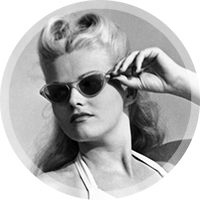

Over the past year, I have become a devoted collector of other people’s memories. People I’ve never met and who are likely long gone from this world. Their ephemera ends up, one way or another, in antique stores, used book shops and other assorted spots where old stuff tends to gather, and I sift through it whenever I encounter it, and choose which stories to take with me.
In an antique mall in far north Chicago, I found a black and white snapshot of two young women, in what appears to be an apartment courtyard lined with wooden stairs; they’re caught seemingly in mid-dance, arm in arm, one with her profile over her shoulder shaded by her hat, and the other mugging for the camera, although her face is blurred. It’s a moment in motion, captured almost by accident, and it still seems to move. The date handwritten on the back reads, “April 28, 1940.”
In an antique mall by the side of the highway somewhere in rural Wisconsin, I found two postcards posted from Chicago in early April of 1941. Elsie sent them back home, presumably to her parents, in St. Clair, Minnesota, while she and Fred were on a trip. The messages are brief; the second one reads simply, “See you soon, boy are we busy.” (I wonder what Elsie and Fred were getting up to that wasn’t suitable for relaying to the folks.) At some point, a younger family member got a hold of the first one and decorated it with a black crayon drawing of a sun and the words “The End” printed backwards. Who knows what inspired that. I’d like to know. Evidently the postcards were worth enough to someone to hold on to anyway. I bought them at first because of their the vintage illustrations on their reverse sides, but more often I look at the words and wonder about the people who sent them and the people who received them.
On the top floor of an used bookstore in Champaign, Illinois, I found a photograph of two older women in a garden behind a house. Their hands are clapsed, and they aren’t smiling, exactly, but both are clearly content. Handwritten on the back is: “Annie C Lewis/Mini Hasting/Sadouc Ill/.” Sadouc, Illinois doesn’t appear to be an actual place, at least anymore, so I don’t know what that was referring to. There’s no date, but I’d guess it was taken somewhere in the loose range of 1930. Despite its probably earlier timeframe, I like it as a bookend to the story begun in the first photo: two women, their friendship immortalized at a certain point of time.
In that same bookstore, I also found a small pencil drawing of a horse. I have no idea why I bought it, but I did. It’s a nice horse. But, mostly, if someone else thought it was important enough to not only create but preserve at one point in time, I’m interested in it.
The most interesting thing I have in my collection so far, however, is the most literal example of this interest. It’s a thin sheaf of typewritten pages, folded in between a sheet of construction paper, bound with a ribbon and adorned with a gold star sticker. Written on the cover is the title: “The Life Story of Our Mother.” Inside is precisely that, the story of Caroline A. Klopfleisch Peik (1860-1950), from her parents who emigrated from Germany and settled on a homestead in Minnesota to her quiet death as a mother and grandmother in the mid-twentieth century. Her daughter wrote and put together the small, heartfelt biography herself.
And, eventually, it ended up in a box of scraps of paper discarded throughout history. One dollar a piece.
The impulse to collect this ephemera is twofold. My first instinct is to protect it, to care for it, to adopt it as if it were so many kittens abandoned in the alley. It pains me that no one wants it anymore, or anyone who once did has passed out of the world and the bits of their lives and memories were scattered to the winds, as it were. Even though I know, beyond my savior self-image, the comfort given by a stranger hoarding these possibly private and certainly important items might be rather small. Which means the larger part of my desire to collect is the fact that I am instantly, deeply attached to the potential of the stories these scraps suggest. It’s fun, yes, to make up stories. But put all the potential together and it begins to build out a bigger story. History is wide and large, and its perpetual waves sometimes seems impossibly impersonal. They sweep away anything not anchored down, and if we’re lucky we can find some things left over in the returning tide—but they’re often just things, separated from our own experience and understanding, as if one day we and ours won’t have been swept away too. As if it isn’t just the same story, over and over again. As if we don’t have to think, seriously and constantly, about what we’re leaving behind.
When I’m asked why I like history or how I find it not boring, I say to start not with the big events but the ordinary people. The events give the people context, but the people give the events meaning. You don’t have to know all the facts about the people. You just have to acknowledge their existence, and they’ll trace a thread back to you naturally. And, maybe, you can learn from history to hold on to what you have, the people and the moments and the potential, and, in the full picture, find your own place.